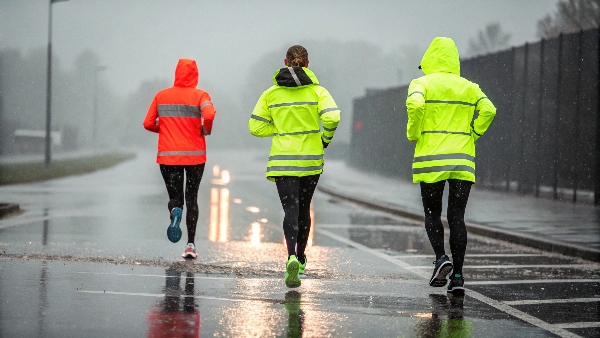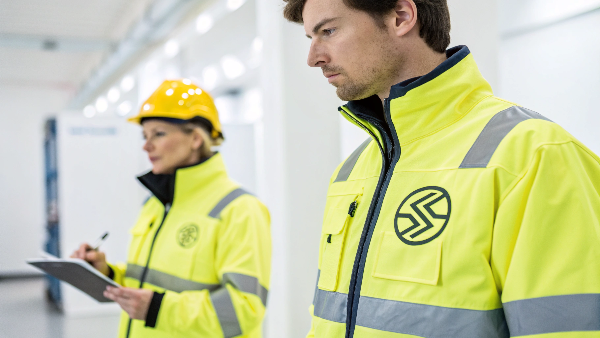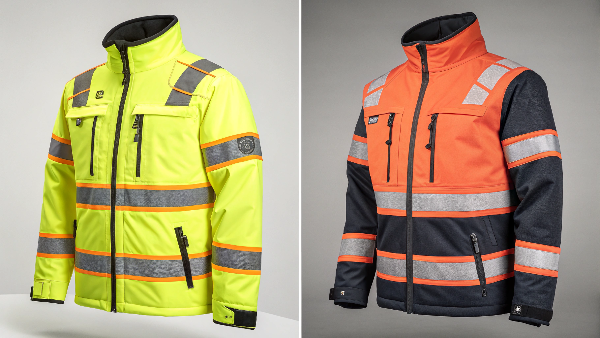Let me paint a picture for you. You have an employee who works late at night, and they are almost invisible to oncoming traffic. This is a recipe for disaster. It’s not a hypothetical. It’s a real problem that many people face every day. The problem is that regular workwear doesn’t provide the visibility you need to keep your people safe. It pisses you off because you’re worried about your people’s safety and the potential liability for your business. The answer is Reflective Heat Transfer Vinyl (HTV). It’s a game-changer. It makes your people visible, keeps them safe, and adds a little style to their workwear.
Why Reflective Heat Transfer Vinyl?
Reflective Heat Transfer Vinyl serves several important purposes, making it an essential material for businesses and individuals alike. Let’s dive into why you need reflective HTV:
Safety and Visibility
The primary advantage of reflective HTV is its ability to provide enhanced visibility in low-light conditions. This makes it ideal for safety gear, workwear, and athletic apparel worn at night or in dark environments. Whether it's for construction workers, roadside assistance teams, or athletes, reflective HTV ensures that the wearer is seen clearly, reducing the risk of accidents.
Fashion and Design
Reflective HTV isn't just about safety; it also adds a unique visual element to clothing and accessories. This material reflects light, creating eye-catching designs that stand out. Whether it’s for fashion-forward streetwear or promotional merchandise, reflective HTV can make any garment look trendy and unique.
Customization
One of the standout features of reflective HTV is its ease of customization. Businesses can easily add reflective designs, logos, or text to garments and accessories, allowing for brand visibility even in low-light conditions. This is particularly useful for companies looking to promote their brand through employee uniforms or promotional items.
Durability
Reflective HTV is made from durable polyurethane material, making it suitable for long-lasting applications on various fabrics. This ensures that the reflective properties remain effective even after multiple washes, providing lasting value.
Versatility
Reflective HTV can be used on a wide range of materials, including cotton, polyester, and poly-cotton blends. This versatility makes it suitable for many types of garments and accessories, from workwear to athletic apparel and fashion items.
Easy Application
Applying reflective HTV is straightforward, making it accessible for both professional and DIY projects. It can be easily cut with vinyl cutters and applied using a heat press or iron. This ease of application allows for quick turnaround times, which is essential for businesses needing to meet tight deadlines.
Sports and Fitness
Reflective HTV is particularly useful for athletic wear, enhancing visibility for runners, cyclists, and other outdoor enthusiasts during early morning or evening activities. This added visibility provides an extra layer of safety for individuals engaging in outdoor sports.
Special Events
Reflective HTV can be used to create unique designs for costumes, party wear, or promotional items that stand out in dimly lit environments. Whether it’s for a nighttime event or a promotional campaign, reflective HTV ensures that your designs are noticed.
Overall, reflective heat transfer vinyl combines functionality with aesthetics, providing both safety benefits and creative design possibilities for various applications.
Now that we’ve established the myriad benefits of reflective HTV, it’s clear why this material is indispensable for businesses focused on safety, visibility, and innovative design. But you might be wondering, what exactly is reflective vinyl used for, and how does it differ from other materials? Let’s explore the diverse applications and unique characteristics of reflective HTV to understand why it's a must-have for your business.
What Is Reflective Vinyl Used For?
Reflective vinyl is used for a variety of purposes due to its ability to reflect light and enhance visibility. Here are the primary uses:
Safety Markings
Reflective vinyl is commonly used to create safety markings such as hazard signs, lane markings, and reflective vests. This application helps improve visibility and reduce the risk of accidents, especially in low-light conditions. For instance, road construction sites often utilize reflective vinyl for traffic cones and barriers, ensuring they are visible to drivers at night.
Advertising
Businesses use reflective vinyl for advertising signs and graphics to ensure their visibility at night or in low-light environments. This can help attract attention and improve brand visibility. For example, a storefront sign made with reflective vinyl will catch the eye of passersby even after sunset, maximizing marketing efforts.
Decoration
Reflective vinyl is also used for decorative purposes, such as custom car decals or stickers for crafts. It adds a unique and eye-catching element to various items. Car enthusiasts, for example, often use reflective vinyl to create custom decals that not only look great during the day but also stand out at night.
Signage
Reflective vinyl is ideal for creating durable and highly visible signs, including road signs, waypoint signage, and commercial vehicle markings. It ensures that these signs are visible in the dark when illuminated by headlights or other light sources. Municipalities and transportation departments rely on reflective vinyl for traffic signs to ensure road safety.
Emergency Vehicles
Reflective vinyl is used on emergency vehicles to enhance their visibility, ensuring they can be seen clearly in all lighting conditions. This is crucial for ambulances, fire trucks, and police cars that need to be easily identifiable during emergencies.
Crafts and DIY Projects
Reflective vinyl is popular in the crafting community for creating custom designs and projects that require high visibility and durability. DIY enthusiasts can use reflective vinyl to make personalized items like backpacks, jackets, and even home decor that stands out.
Reflective vinyl is a versatile material that combines functionality with aesthetic appeal, making it suitable for a wide range of applications where visibility and safety are paramount.
What Is Reflective HTV?
Reflective HTV (Heat Transfer Vinyl) is a specialized type of heat transfer material designed to reflect light, making it highly visible in low-light conditions. Here are the key features and uses of reflective HTV:
Composition
Reflective HTV consists of very small glass beads embedded in a layer of polyurethane film, which reflects almost all the light that shines on it. This unique composition is what gives reflective HTV its exceptional visibility properties.
Visibility
Reflective HTV glows when hit with a light source, making garments highly visible in dark environments. This is particularly beneficial for safety gear and athletic apparel, where visibility can be a matter of life and death.
Applications
Reflective HTV is used in a variety of applications, including:
Safety Gear and Workwear: Enhancing visibility for workers in low-light conditions.
Athletic Apparel: Making runners and cyclists more visible during early morning or evening activities.
Fashion and Design: Adding eye-catching elements to clothing and accessories.
Customization: Allowing businesses to add reflective designs, logos, or text to garments.
Versatility
Reflective HTV can be applied to various fabrics, including cotton, polyester, and poly-cotton blends. This versatility makes it suitable for a wide range of garments and accessories.
Durability
With proper care, reflective HTV can last for more than fifty washes, ensuring that the reflective properties remain effective over time. This durability makes it a cost-effective solution for businesses looking to invest in high-quality safety gear.
Easy Application
Reflective HTV can be easily cut with vinyl cutters and applied using a heat press or iron, making it suitable for both professional and DIY projects. This ease of application allows businesses to quickly produce customized garments without the need for specialized equipment.
Varieties
Reflective HTV is available in different colors and finishes, including rainbow effects and neon colors. This variety allows for creative and unique designs that stand out.
Safety Considerations
While reflective HTV enhances visibility, it's important to note that it's not a substitute for certified safety materials like 3M reflective tape for professional safety gear. Businesses should ensure that their safety gear meets all necessary safety standards and regulations.
Reflective HTV combines functionality with aesthetics, providing both safety benefits and creative design possibilities for various applications in fashion, sports, and safety wear.
Is Reflective HTV Hot or Cold Peel?
Reflective HTV can be either hot peel or cold peel, depending on the specific product. Here’s a closer look at the differences:
Hot Peel
Hot peel HTV can be peeled off immediately after pressing while it is still hot. This method is quick and convenient, allowing for faster production times. However, it requires careful handling to avoid burns and ensure that the vinyl adheres properly.
Cold Peel
Cold peel HTV, on the other hand, needs to cool down completely before the carrier sheet is removed. This method ensures that the vinyl has adhered properly to the fabric, reducing the risk of peeling or lifting. While it takes a bit more time, it often results in a more durable application.
Warm Peel
Some reflective HTV products are described as warm peel, meaning they should be allowed to cool for at least 10-15 seconds before peeling back the carrier. This strikes a balance between hot and cold peel methods, offering both convenience and durability.
It’s important to check the specific instructions for the brand and product you’re using, as peel temperature can vary between manufacturers. Allowing the HTV to cool at least slightly before peeling appears to be the common recommendation for best results with reflective HTV.
What Temperature Do You Use for Reflective Vinyl?
The temperature for applying reflective vinyl varies depending on the specific product and application method. Here are some key points:
For Siser EasyReflective HTV
The recommended application temperature is 305°F (152°C) for 15 seconds with medium pressure.
For General Vinyl Applications
The minimum application temperature typically ranges from 40°F to 50°F (4°C to 10°C) for most vinyl products.
Some specific products, like Schein holographic films, require a higher minimum surface temperature of 70°F (21°C).
For Reflective Sheeting
EnduraLITE 48000 and M8512 reflective sheeting requires a minimum surface temperature of 59°F (15°C).
EnduraLITE 8100 and Super Engineer Grade reflective sheeting perform best when applied in an ambient temperature range between 69°F and 77°F (20.5°C to 25°C).
For Heat Press Applications
The temperature can be significantly higher, as seen with the Siser EasyReflective HTV example at 305°F (152°C).
It’s important to note that these temperatures can vary based on the specific product, substrate, and application method. Always check the manufacturer’s instructions for the exact product you’re using to ensure proper application.
How Long to Heat Press Reflective Vinyl?
The heat press time for reflective vinyl varies depending on the specific product and fabric type. Here are some general guidelines:
For Siser EasyReflective HTV
Press for 15 seconds at 305°F (152°C) with medium pressure.
For Reflective HTV on Non-Stretchable Fabrics
8-20 seconds at 140-160°C
For Reflective HTV on Stretchable Fabrics
10-20 seconds at 150-170°C
For Reflective HTV on Flame Retardant Fabrics
10-20 seconds at 160-180°C
For Reflective HTV on Water Repellent Fabrics
12-60 seconds at 100-160°C
For Reflective HTV on Fabrics Requiring Industrial Wash
10-20 seconds at 160-180°C
For 20" Reflective HTV Vinyl
Press for 10 seconds at 320°F with light to medium pressure
For 16" Reflective Fabric
Press for 20 seconds at 340°F with firm pressure
It’s important to note that these times and temperatures can vary based on the specific product and fabric type. Always check the manufacturer’s instructions for the exact product you’re using. Additionally, it’s recommended to preheat the garment for 3-5 seconds before applying the vinyl to remove wrinkles and moisture.
Conclusion
Reflective Heat Transfer Vinyl (HTV) is a versatile, durable, and highly effective material for improving visibility and safety in a variety of applications. From safety gear and workwear to fashion and athletic apparel, reflective HTV provides a unique combination of function and form. It’s easy to apply, can be customized, and works on a variety of fabrics, making it a valuable asset for both businesses and individuals.
Whether you want to make your employees safer, create eye-catching promotional items, or add a unique design element to your products, reflective HTV is the solution you’re looking for. By understanding its uses, how to apply it, and its benefits, you can make informed decisions that will improve the visibility, safety, and appeal of your products.
So, what are you waiting for? Invest in reflective HTV today and see how it can make a difference for your business and your customers.



